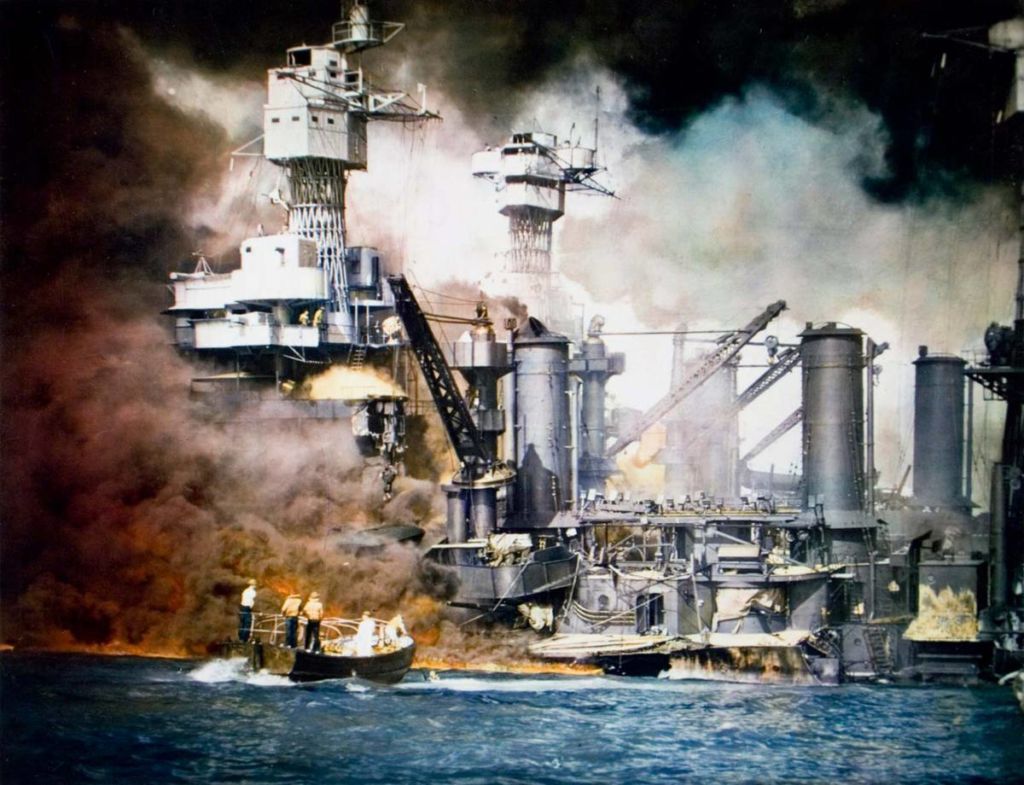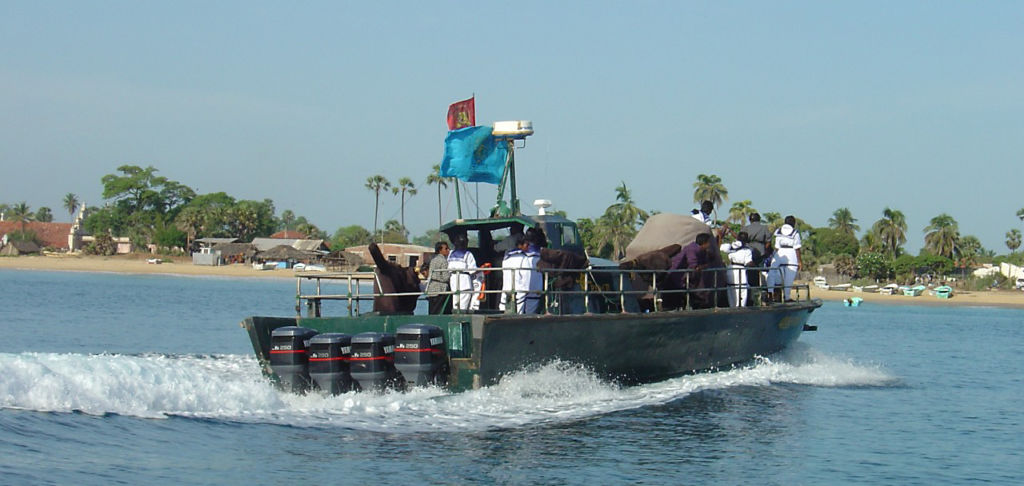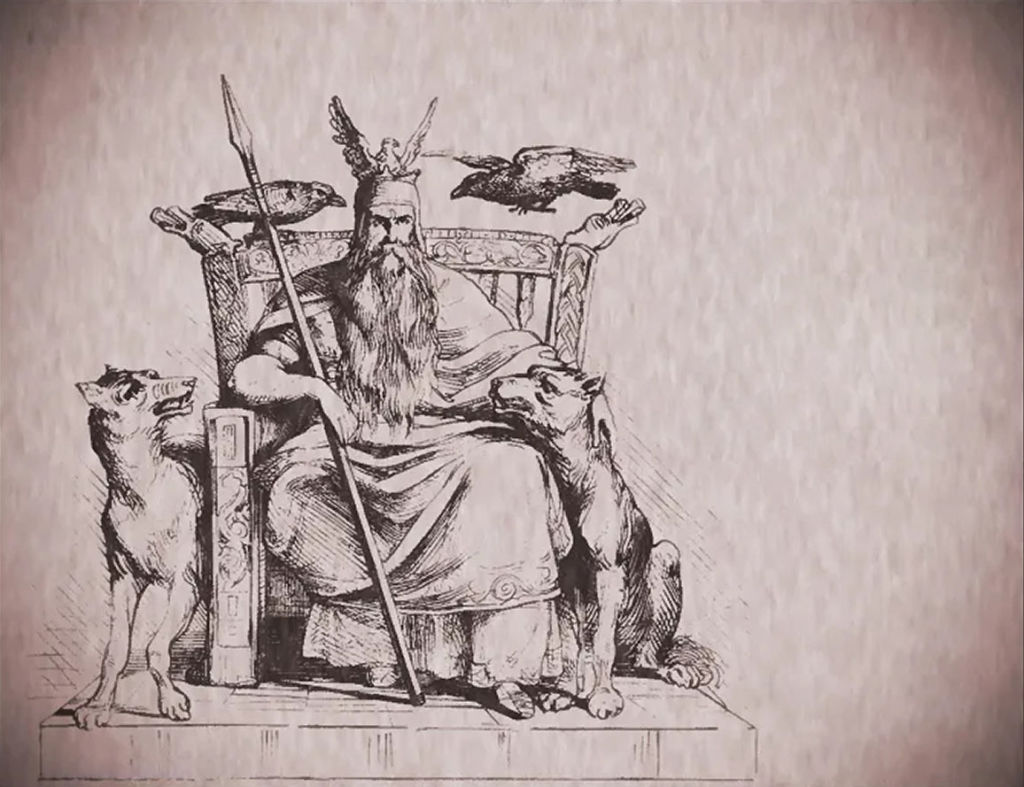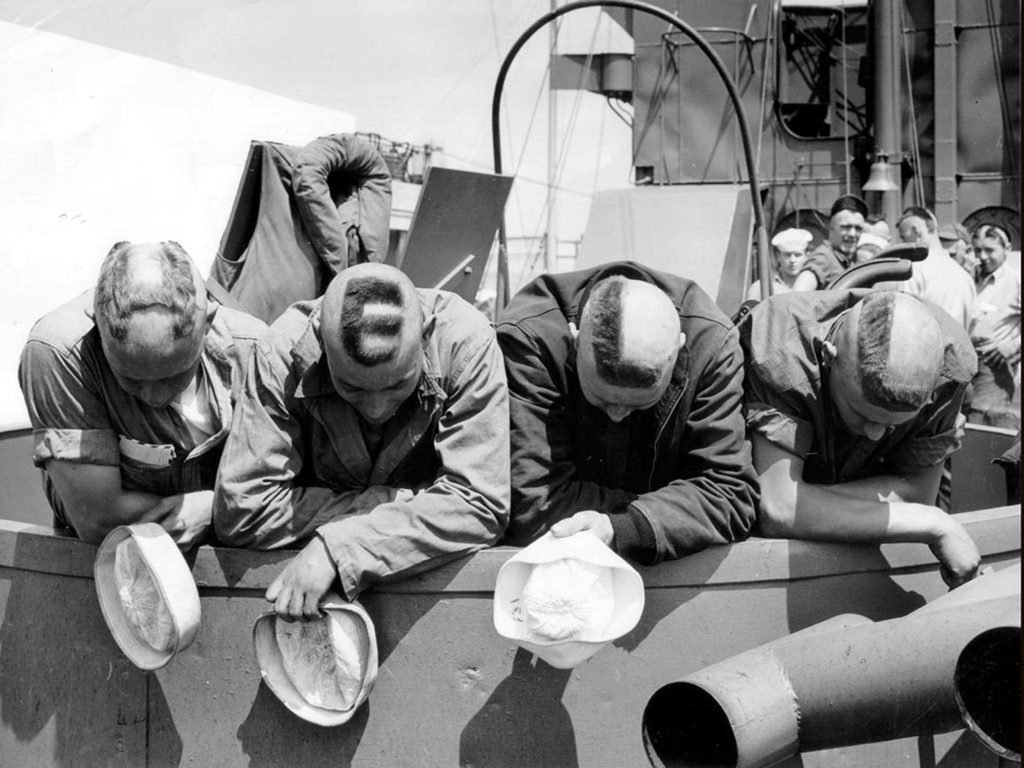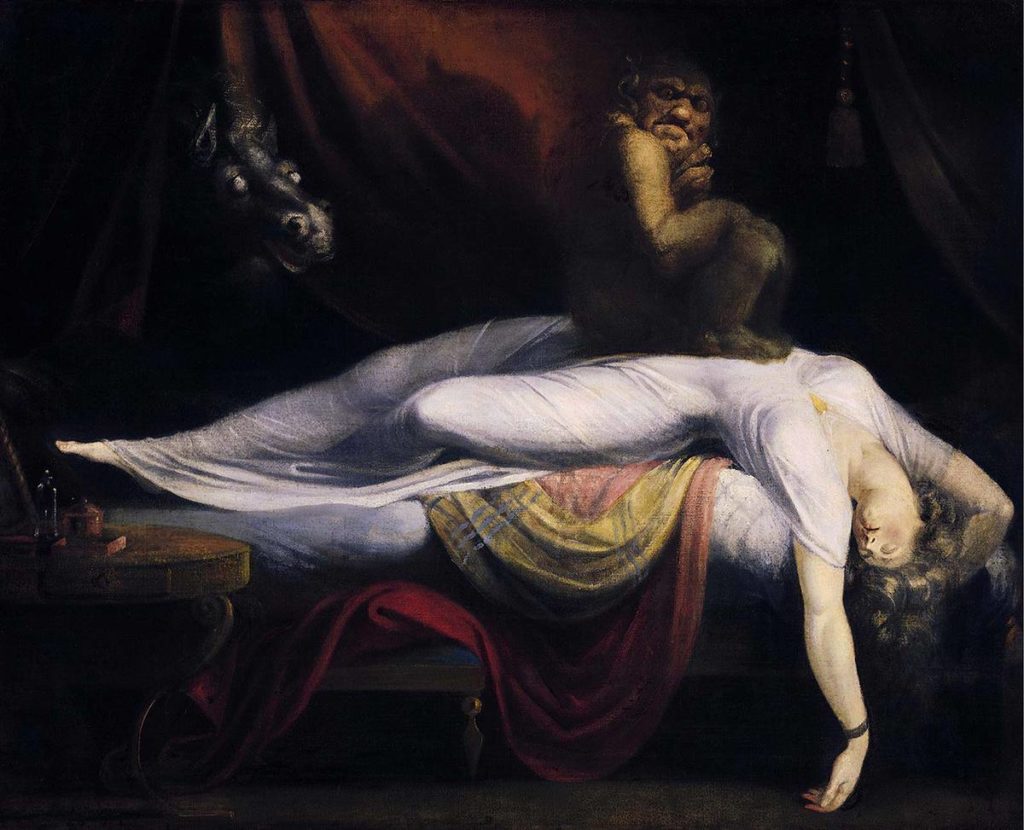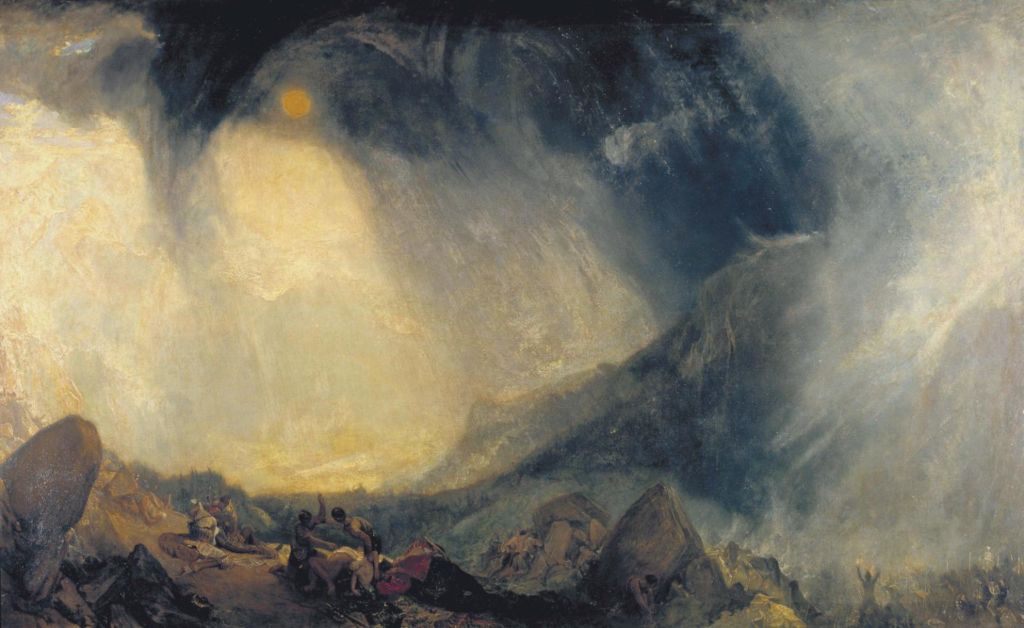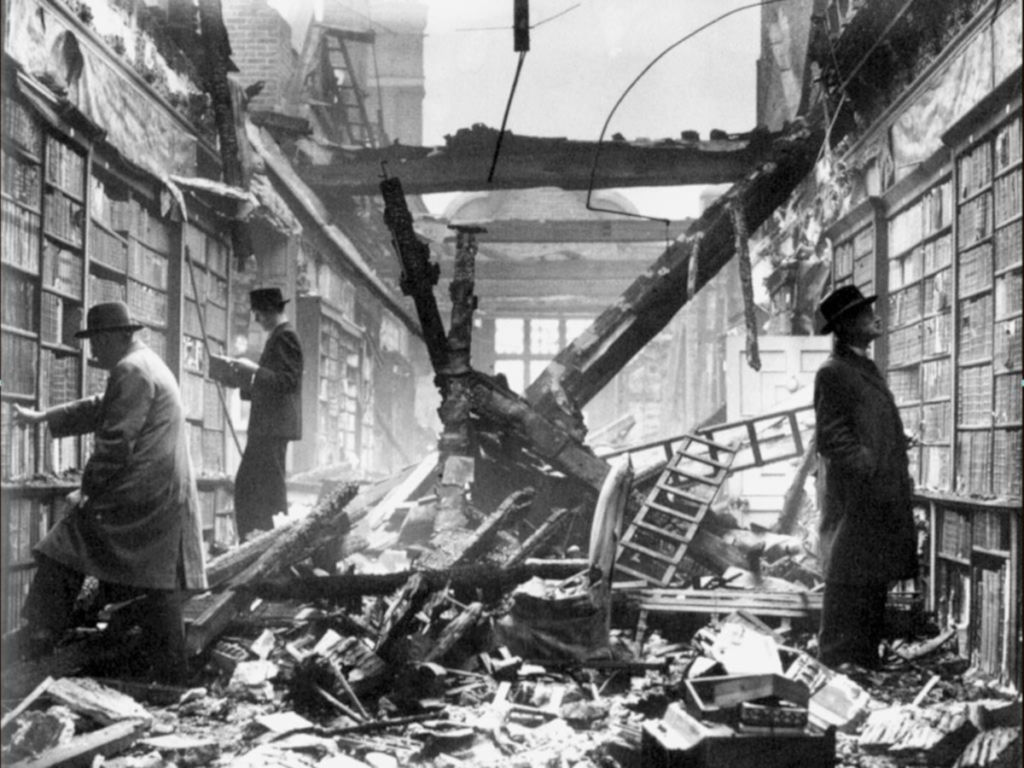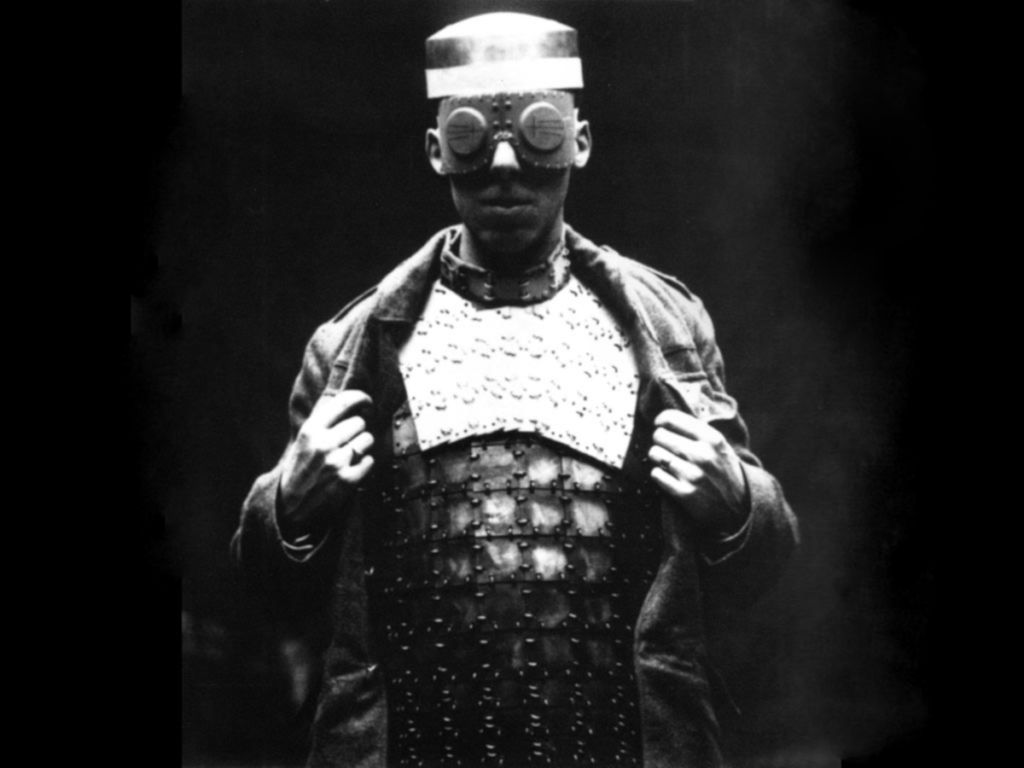Starting in September 2020, once a month Switch (on Paper) will publish an excerpt from Jean-Yves Jouannais’ Encyclopédie des guerres (The Encyclopedia of Wars). What started out as an experiment in oral literature is gradually taking the form of a book, scheduled for release in 2030. Until then, we would like to bring you a few excerpts, published here in alphabetical order like the entries in a vast atlas of wars. Today’s entry is Fire.
“The assailants retrieve fire to catapult it at the palace, and are well provided for.”
(Lancelot du lac, translation François Mosès, after Elseth Kennedy’s edition, Le Livre de poche, Paris, ch. XIII, pp. 228-229)
The Impossible King
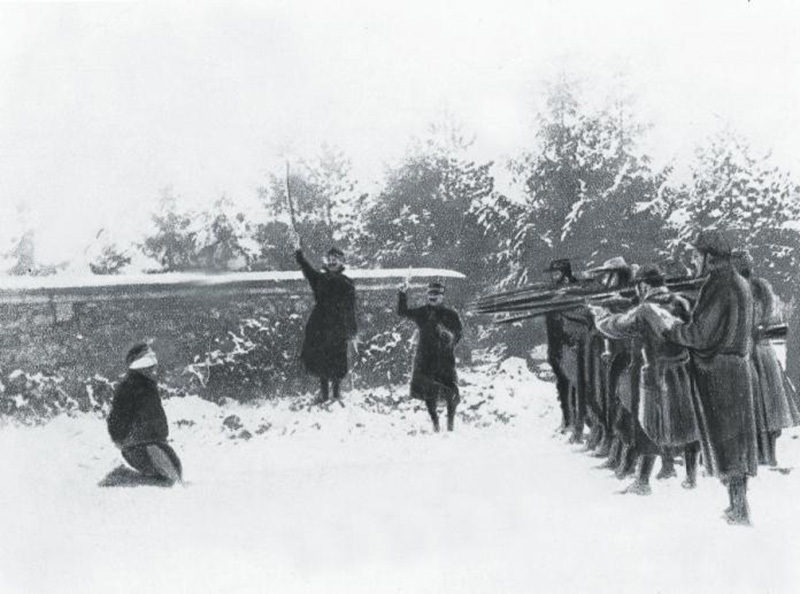
Firing squad during the First World War and the great mutinies of 1917. Rue des archives / Leemage
Erik I was the king of Denmark from 1095 to 1103. The prince’s birth remains a mystery to us; we know as little about how came to lead his country as we do about his government’s doings. Some authors report that he set up considerable colonies on the islands of Chersonesus Cimbrica. But historians disagree on the facts. We know from chronicles that he was called “Eigod”, which means “Always Good”. But did that mean the king was a courageous man, or that under his reign the harvest was always plentiful? More troubling, however, is the theory that purports Eric I never set fire beyond his borders, never had a taste for battle, never tasted what it was like to set cities ablaze. In this respect he was alone in his lineage, his era. This kind of conjecture is perplexing. But one answer can be found in the Chronicon Roskildense, a chronicle written in Latin that recounts the main historical events in Denmark from 826 to 1140. Unlike Gesta Danorum, due Saxo Grammaticus, which confirms the established history without any additional detail, Chronicon Roskildense relates misinterpreted events that make up a true basis for sometimes less-than-glorious moments, but have an important place in the eyes of contemporary historians. It is how we learned that, from his early childhood years, the boy who would reign under the name Erik I was terrified by storms, flames and any other element of fire found throughout Creation.
(Off to) Fire
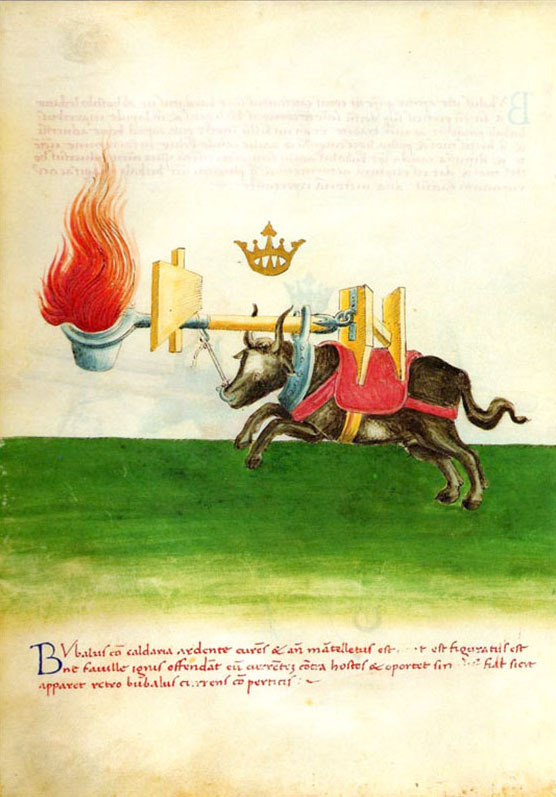
Device for carrying fire according to De rebus militaribus by Mariano Taccola, 1449
Ante Pavelic was a farm worker in a community in the Vukovar region. As an aviator, his specialty was crop-dusting: pesticides, herbicides, fungicides, cleansing muds, liquid effluents… His work tool was an An-2, a multiuse single-motor biplane designed in the 40s by the builder Oleg Antonov. This robust machine, efficient and easy to repair, was mass-manufactured in over 18 000 copies, and fulfilled various functions in the skies over Russia, Poland, Colombia, Laos, China, Angola or Cuba: passenger transport, fire fighting, meteorological exploration, emergency relief, but most of the time it was used for farming. In August 1990, when war hit Croatia, the Croatian army was in worse state than the Serbian. During the first months of war, the Croatian police had to fight. The National Guard was created April 11, 1991, and gradually transformed into the Croatian Army from March 1992 onward. It owned only a handful of T-34 tanks, which were post-war surpluses, and many units had no weapons, or only guns left over from the Second World War. The air forces were theoretical too, counting only five requisitioned An-2 crop-dusters amongst their ranks, converted into makeshift bombers. Ante Pavelic, farm worker turned bomber in this improvised air force, recalls: “We didn’t see a very big difference. We didn’t even have uniforms. We left for battle the way we did for the fields.”
(Take) Fire
1/
In the siege of Montauban by Louis XIII’ armies from August to November 1621, Monsieur de Pontis, who served under three kings, recalls how enemies threw twenty kettles of boiling pine tar into the nearby trenches, subjecting a great many people to the miserable state of being burned alive in their clothing. Several died, others escaped by cutting off their clothes, which incited the enemy to shout at them, mockingly: “To the grill! To the grill!”
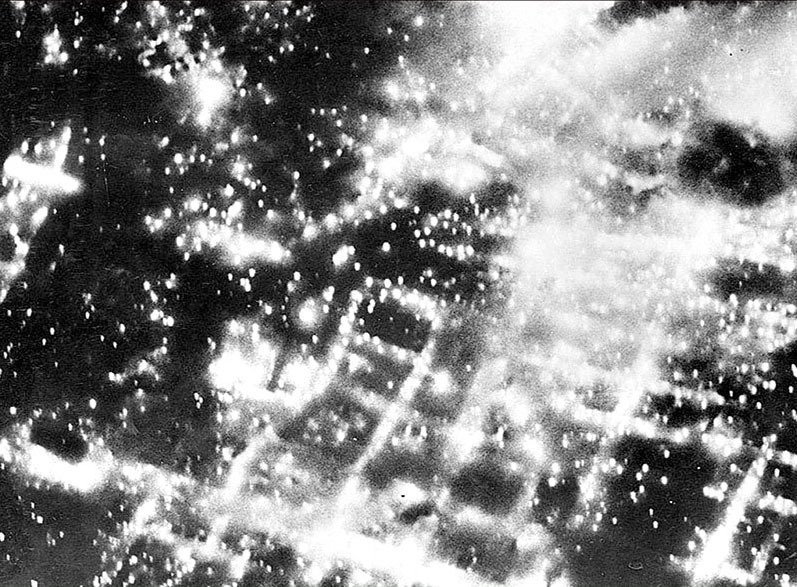
Air raid on Braunschweig in 1944 © Archives HP Bernd Aumann
2/
The battle at Yalu River was one of the most impressive naval operations in the first Sino-Japanese war. It should have been named the Yellow Sea Battle because the clash did not occur at the river itself, but at its mouth. On September 17, 1894, ships from the Imperial Marines and the Chinese Beiyand flotilla came to a clash. At 2 700 m, the Japanese aimed their canons on the right flank of the Chinese line. The twin cruisers Chaoyong and Yangwei immediately burst into flames. This was due to the fact that the war ships’ decks and central superstructure—with its many partitions—had been cleaned like the floors of Buckingham palace. Every day, they were buffed with varnish containing flammable solvents. Prey to the intense flames, the two ships attempted to save themselves by wrecking onto a wooded riverbank. In an instant, they set ablaze a forest of Moso bamboo (Phyllostachys edulis).
(Carry the) Flame
1/
The Bulgarian tsar Simeon I, in a war against the Greeks, dreamt of nothing other than personally sitting on the throne of Constantine’s feeble successors. The peril was extreme. Romain Lécapène was put in command of the fire fleet, that is, ships armed with Greek fire. In 922, the Bulgarians, having reached Bosporus, fought the Byzantines there; in 923, they seized Andrinople. On September 9, 924, they drew a peace treaty: the Byzantines would offer every year, “until the end of time”, a thousand richly-embroidered silk tunics to the Bulgarian Tsar’s court, in exchange for which Simeon returned the Greek cities along the Western coast of the Black Sea, between the mouth of the Danube and Constantinople. Having grown old, Romain Lécapène abandoned state affairs to cloister himself at the Proti monastery. In 945, he called 300 monks there from all corners of the empire, and confessed his sins before this jury, asking every single one of them for forgiveness. One confession had more weight than the others: his past as a commander of the so-called fire fleet, of having gone against God’s will, against the nature of the elements, and insulted the harmony of Creation by so ostentatiously carrying fire along the water’s surface. For that, and for that alone, he requested to be whipped by a young novice. Romain Lécapène died June 15, 948. His body, returned to the capital, was buried at the Myrelaion monastery.
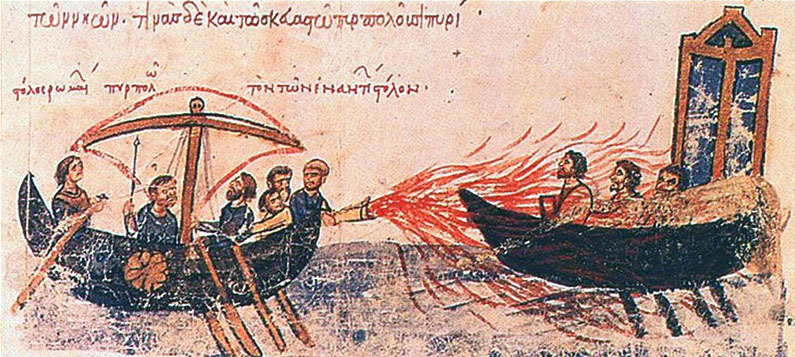
A ship belonging to the rebel Thomas the Slav, using Greek fire against a Byzantine ship 821. 12th century illustration from the Madrid Skylitzes
2/
The Society of Pharmacy History was interested in a report addressed to the Artillery Committee in 1831, on ignitable cannonballs developed by a pharmacist from Sèvres named Lefortier. It claimed he had been hawking his invention for years to the departments of war and the marines. Through the recommendation of a former representative, Monsieur Bedock, he received permission to conduct a number of experiments. Lefortier presented cannonballs that required, or so he stated, no gun, no opening; they should, upon explosion, ignite and release noxious gases. Lefortier was therefore a kind of precursor in the field of firebombs and asphyxiating gases: he sought to unite these two properties in one single projectile. His balls, 24-caliber, weighed 14 to 16 kilos. The metal casing (an iron and lead alloy) was unequalled in thickness; it could vary from 10 to 12 layers. The first experiment was conducted at Saint-Cyr school in 1825; the following experiments took place in Douai in 1827, then in Lorient in 1828 and 1829, always under the patronage of the Ministry of the Marines. Official reports of these tests are not very conclusive. In fact, they are all clearly negative, especially the one from Lorient. Military experts observed that “the explosion, minor, barely audible, produced abundant smoke, an insipid (sic) odor that brought on coughing fits and might be of a nature to bother the men on a battery of ships full of such smoke. Smoke of this kind, whose source would be unknown, could perhaps worry the sailors or sound the alarm in the enemy’s camp for a moment. But this does not make the ball a miracle weapon. To be clear, and to put it bluntly, this is a ignitable cannonball and asphyxiate that neither sets off a fire nor releases any gas.” The Artillery Commission definitively rejected the invention by the pharmacist Lefortier with the following conclusion: “It has been well proven that the ignitable composition of M. Lefortier’s invention is worth nothing. At least not in times of war. Other uses may perhaps be discovered for this invention, but none of them will be military in nature.”
(The Weight of) Fire
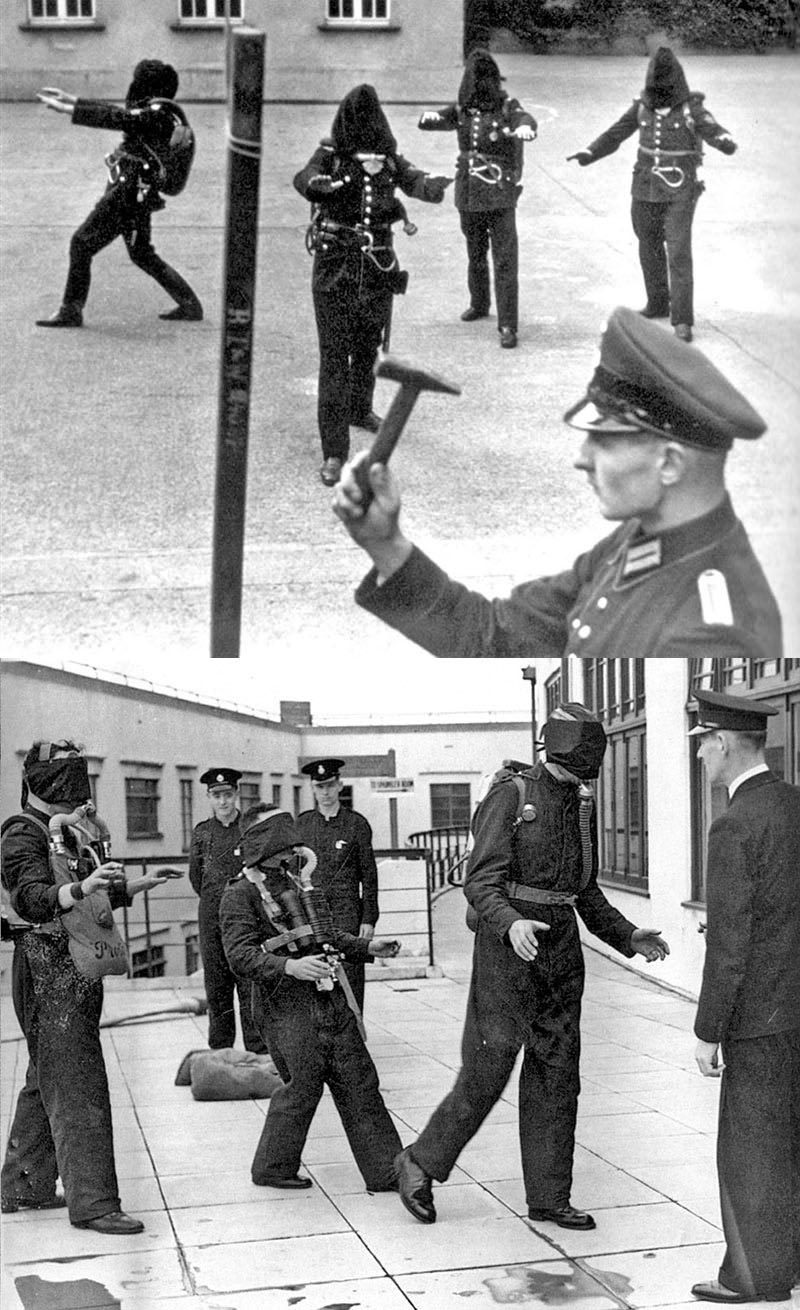
German and British firefighters, respectively tested on their ability to follow a sound in the dark, ca 1940
The idealists deny that fire is matter. It has no weight; or rather it has negative weight. The atomists, on the other hand, assert that fire has corporeality, gravity, basically, it is matter. But they say its atoms are smaller than those in other elements, further apart from one another, which explains why it is perceived as extremely light. The ideal of corporeal, heavy fire long enjoyed the prestige of Greek atomism—did Galileo not state there were “ignicles” or atoms of fire?—a prestige that was enhanced by the experimental verification of the gravity of air in the mid-17th century. But one century later, for example in Baume’s work, which is a source of authority in France right now, fire is an elements where “we cannot be certain whether it does or does not have weight” because “there are experiments that support and deny both views”. For Scheele, however, heat, fire and light are imponderable combinations. If in Lavoisier’s time, the imponderability of energy released during reaction was a condition for developing molecular chemistry, a century and a half later, its ponderability had become one of the conditions for progress in atomic chemistry. Thus, as science evolved, one same reality could be seen from two contradictory angles. A higher phase of the theory finds, in a renewed form, an aspect of this reality overlooked by the earlier phase and recognized, on the contrary, by an even older phase. In this regard, we often turn to light theory. And though less prevalent, the example of heat theory also seems relevant: the weight of fire, conjectured by the Greek atomists, the experimentation, practice, that drove Lavoisier to deny it, has forced modern atomists to reaffirm it. And so in 1919, Perrin believed that the hydrogen condensation in helium and other heavier elements “with a loss of three centigrams per gram” was enough to “explain a hundred billion years of solar radiation at the current rate”. And so it was agreed, to satisfy a noble curiosity, that one could weigh the sun’s fire in centigrams. An experiment that led to Hiroshima, the morning of August 6, 1945. The city did not go up in a puff. The mushroom blast, 10 000 m high, may have given that impression. But it was actually the weight of fire that leveled the city. Not condensation, nor dissipation: 90 000 buildings ground into dust by flames.
Translation: Maya Dalinsky
Cover: Colour-tinted photo of sailors in a motor launch rescuing a survivor of the stricken USS West Virginia shortly after the Japanese attack on Pearl Harbor, December 7, 1941. © U.S. Army Signal Corps/National Archives, Washington, D.C./Naval History and Heritage Command (USA C-5904)
